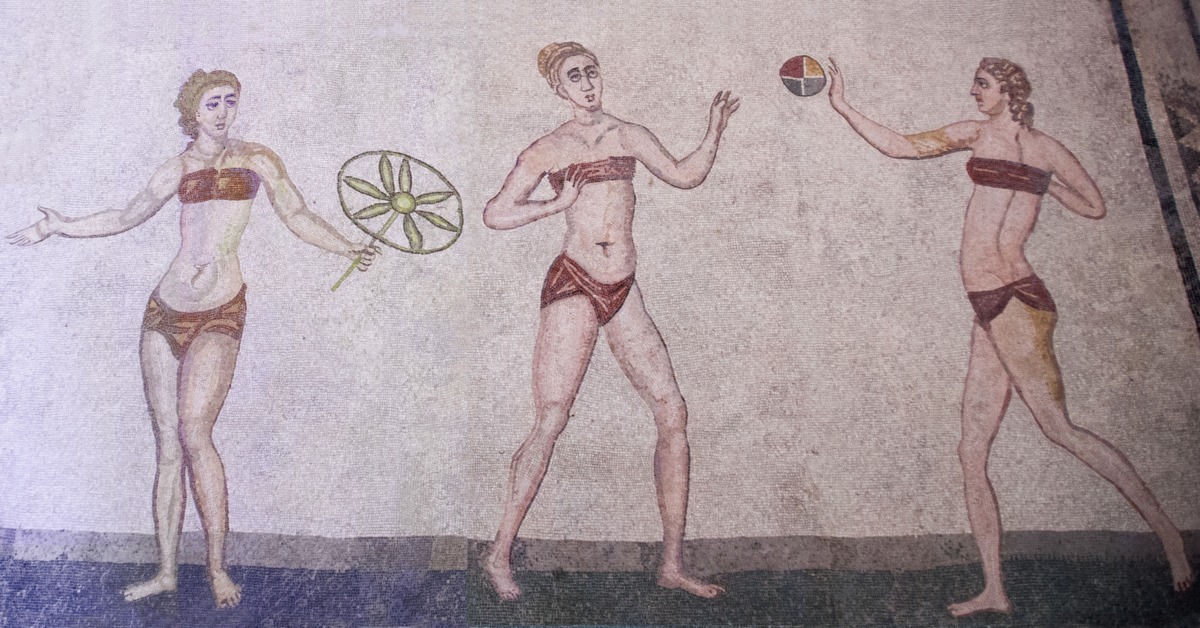A mosaic in an ancient Roman villa in Sicily features girls dressed in what look like modern-day swimwear.

A mosaic from the Villa Romana del Casale, which dates to the early 4th century, depicts young women in garments that resemble modern-day bikinis. It’s fascinating to think that this ancient artwork could have inspired today’s fashion trends, but let’s not get ahead of ourselves.
Located just three kilometres from the Sicilian town of Piazza Armerina, the ancient villa features one of the most extensive collections of ancient Roman mosaics in the world, leading to its designation as a UNESCO World Heritage Site.

Among the numerous mosaics that embellish the floors of the different rooms and passageways within the structure, there is one that has consistently captured the interest of present-day visitors.
In one of the small rooms of the villa referred to as the Sala delle Dieci Ragazze (“Room of the Ten Girls”), which possibly served as a private bedroom or a service room, there is a mosaic on the floor that showcases several girls attired in what seems to be ancient equivalents of the modern-day bikinis introduced by French designers in 1946. The scene undoubtedly strikes the visitor as very modern.

Of the ten women portrayed in the mosaic, nine appear to wear what resembles a two-piece swimsuit. At a closer look, however, you can see that the women are not actually wearing bikinis, but rather what appears to be athletic wear or even underwear.
According to Josho Brouwers, the lower portion of the garment features a cloth or leather loincloth referred to as a subligaculum, a more skimpy version of the male perizoma or loincloth. This was commonly worn as underwear by athletes and slaves. In 1998, archaeologists in Britain discovered a leather “thong” from a well that dates back to the first century AD and perfectly corresponds to a modern bikini bottom. It is presently showcased at the Museum of London.

The upper component of the “bikinis” donned by these girls features a breastband, a garment already used in ancient Greece. The Greeks called it a mastodeton or apodesmos, while the Romans referred to it as a strophium. Usually crafted from linen, breastbands were worn by women with an active lifestyle, including athletes.
The mosaic displays girls participating in sports, with the “bikinis” obviously functioning as athletic wear rather than swimwear. It is difficult to discern the activity of the girl on the far left of the top section, but the one beside her is holding weights that are used to improve long jump momentum by swinging the arms backward, rather than building muscle mass. In the center, one girl is shown preparing to throw a discus, while the two on the right side are depicted running.

On the lower portion of the mosaic, there are two girls on the right side who appear to be playing a ball game. Also mentioned in Homer’s Odyssey, ball games have been present since ancient times and were particularly played by adolescent boys and girls. One variation involved the losing team carrying the winners on their backs after the match. In this instance, the girls seem to be playing an early version of volleyball.
Towards the far left of the lower register, a woman, who may be older, is seen wearing a transparent yellow dress and holding a rose crown and palm frond. These items were traditionally given as prizes to the winners of athletic competitions. The girl situated in the center of the register has already received a palm frond and is shown in the act of placing the victor’s crown upon her head. Between the winner and the woman in yellow, another girl is holding what seems to be a stylized flower, though some interpretations suggest it might be a type of parasol or even a stylized wheel from a chariot.

Despite the common belief that women in the Roman Empire were not involved in sports, they did, albeit with certain limitations. For instance, women were not permitted to compete with men. Furthermore, while it was customary for men to exercise in the nude, following the Greek tradition, the same was not socially acceptable for women to engage in public nudity. As a solution to this, the ancient “bikini” provided women with a comfortable outfit to exercise in, without violating the cultural norms of ancient society.
So, all in all, those ancient Romans bikinis were not meant to be used as swimwear, but were definitely closely related to sports. And they also had to do with the comfort that modern bikinis gave to women when they were invented.
